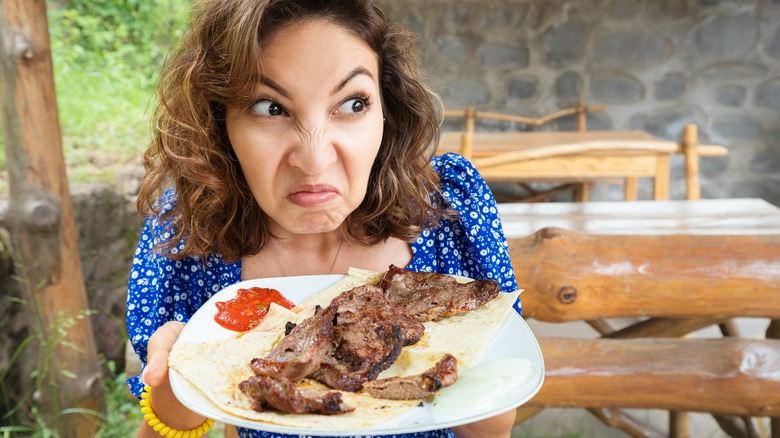Here's How Long You Can Keep A Dry Aged Steak In The Fridge
Dry aging is a specialized process where steaks are intentionally aged in controlled environments to enhance their tenderness, texture, and flavor. You can dry age meat at home or purchase it already aged. Doing it yourself involves keeping the meat in a humidity-controlled environment with good airflow, typically for several weeks. However, once the aging process is complete and the steak has been cut, its shelf life decreases significantly. If you've purchased a dry-aged steak and plan to store it in your home refrigerator, it's essential to know how long you can expect the steak to last.
Generally speaking, dry-aged steak should be stored in the fridge for only three days. This short timeframe ensures the steak is fresh, tasty, and safe for consumption. The dry-aging process naturally reduces moisture, concentrating flavors and tenderizing meat, but the meat is still sensitive to bacterial growth once outside its controlled environment.
Keeping dry-aged steak beyond three days in the fridge may result in changes to texture, flavor degradation, or even spoilage; potentially making the steak unsafe to consume. Knowing how long your steak stays fresh is key to fully enjoying the unique flavor profile and exceptional quality that dry-aged steak offers.
Proper storage techniques to extend freshness
Proper storage techniques will affect how long dry-aged steak remains at its best quality. Firstly, store the steak at a temperature between 34 and 38 degrees Fahrenheit. This cold temperature range slows bacterial growth and preserves freshness. The ideal place to store your steak is at the back of the bottom shelf, the coldest and most consistent area of the refrigerator. It's also essential to manage how your steak is wrapped because it's not like regular steaks. Dry-aged steaks should not be wrapped in plastic film, which can trap moisture and accelerate spoilage.
Instead, opt for butcher paper or parchment paper, materials that allow limited airflow, which keeps the steak dry and still protected. Vacuum sealing is another excellent option because properly vacuum-sealed dry-aged steaks can safely last up to seven days in the fridge. It accomplishes this by minimizing exposure to air, thus greatly reducing spoilage potential. Avoid direct contact with other foods (particularly raw meats or strong-smelling foods) to prevent cross-contamination or odor transfer. Handling and storing the steak the right way helps it retain its flavor, texture, and aroma so you can enjoy it at its culinary peak.
Recognizing when dry-aged steak has spoiled
Dry-aged steaks naturally have distinctive characteristics, including a darker color and an aroma that's more robust than fresh steaks. However, distinguishing these normal attributes from spoilage signs is critical for food safety. When dry-aged steak begins to spoil, noticeable changes occur. The smell is often the first indication because a spoiled steak will produce an unpleasant, rancid odor similar to ammonia that's unmistakably off-putting. Beyond smell, texture changes provide another crucial clue which help you know it's time to throw it out.
A slimy or sticky surface suggests bacterial activity, which is a definite indicator the steak should not be consumed. Minor discoloration may occur naturally due to oxidation, but extensive darkening or unusual mold growth (such as green, white, or blue spots) signals spoilage. If you're in this boat, it's critical to discard your steaks immediately without attempting to salvage them by trimming or washing as harmful bacteria can penetrate deep into the meat. You won't be able to save this one by just throwing it on the grill, unfortunately.
Properly identifying spoilage ensures you avoid serious foodborne illness, protecting both your health and enjoyment of quality meats. Paying close attention to these visual, tactile, and olfactory indicators will help you safely savor the unique taste and texture of dry-aged steak.


